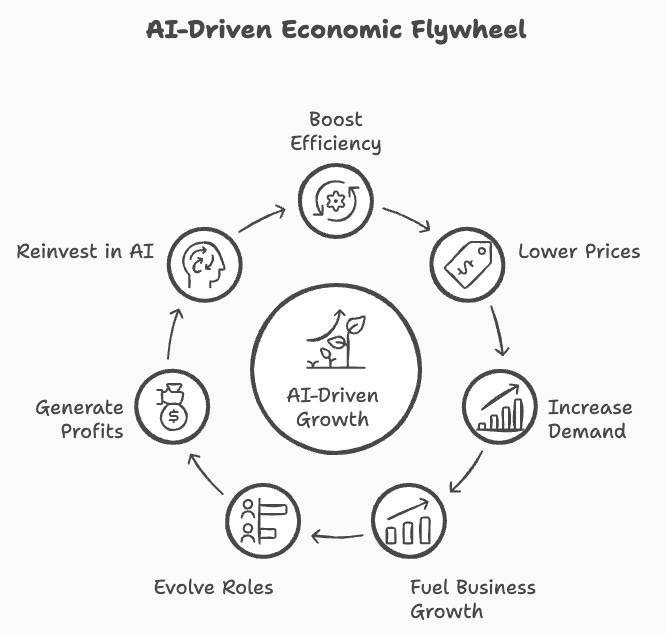Jevons Paradox & Post-AI Job Market
Jevons Paradox applies not just to compute, but also to knowledge worker jobs as well.
Jevons paradox, attributed to economist William Stanley Jevons describes how technological improvements that increase efficiency often leads to a higher consumption of the resource. He observed it in 1860s, in the era of coal powered engines, when improvement in efficiency in usage of coal led to an increased consumption of coal rather than the expected reduction in consumption.
Very recently this paradox started trending on social media, specifically around the release of DeepSeek. DeepSeek was not only a ground-breaking model in its licensing and performance, but it was also marketed as super efficient in the training phase. The market’s knee-jerk reaction was to assume NVIDIA’s days of stellar stock performance and order book growth are soon to be over. A lot of industry leaders including Satya Nadella then posted about Jevons paradox and how more efficient algorithms and more advancements in models will only lead to more consumption of these models by users and therefore drive more demand for NVIDIA.
Even the folks who buy Jevons Paradox bull case for NVIDIA debate its applicability when it comes to Jobs. That is what they are essentially doing when they say AI is going to lead to net loss of jobs worldwide. This is also a favorite weapon of activists who push for strict regulations against AI and harm the pace of development of technology in their own countries. When applied to knowledge work, Jevons paradox presents a very counterintuitive perspective on how increased reliance of AI driven automation will lead to increased employment in knowledge work and not reduce it.
Phase 1: AI Integration & Efficiency Gains
We are currently in the first phase where businesses invest in AI across industries. They often start with well-known use cases like automation, customer support, programming where AI has proven to show gains in efficiency. This leads to cost reduction, better resource allocation and increase in productivity. The companies that are on the leading edge go beyond productivity gains and leverage AI for business innovation leading to better products, designs, discoveries and even new business models.
Phase 2: Business expansion driven by efficiency and innovation.
In the second phase, the cost savings and productivity gains achieved in Phase 1 will create competitive advantages and opportunities for growth. This will include lower prices for goods / services that tap into increased demand from new segments of consumers, or from market creation from innovative and new products and services. Increased competition can also lead to expanding markets or customer segments.
Phase 3: Growth drives evolving labor needs.
The increased demand from phase 2 requires businesses to scale their operations and this inevitably leads to increased labor demand. The roles demanded by this growth flywheel will inevitably be different due to the impact of AI. As businesses race to produce more goods and services to meet the rising demand, they will need more humans to help them with it. In spite of AI driven automation every business area including Management, Strategy, IT, Sales, Marketing, Logistics, Supply Chain, Research and even customer support is going to need more people to grow the business. Sales and marketing will lead to the increase customer interaction and market expansion. Logistics and supply chain will need to cater to the larger volume of goods and and its movement in an expanded market. Research and development will have to continue to innovate to stay ahead.
All of these roles will evolve in a way that it takes advantage of all the advances in AI tooling and productivity boosts that come with it. There will also be new roles that are going to be created. Jobs will move from today’s mundane corporate jobs to ones requiring creativity, critical thinking, strategy, emotional intelligence, human interaction and complex problem solving. All roles including new and existing roles will evolve to have some form of human-AI collaboration where you are either working alongside AI, managing AI or take decisions based on AI output. This is what feeds the flywheel of economic expansion.
There will always be some roles that will always get eliminated. This has been true about every technology wave in the past and will hold true for AI as well.
When ATMs automated cash handling, the number of bank tellers initially decreased. But as banking expanded on the rails of this technology change, banks opened more branches and tellers got into customer advisory role in these branches. Even today these bankers do some of the tasks of tellers, but they prefer to do more value-adding task for the customer and the bank.
Spreadsheets, electronic calculators and databases did not eliminate accountants but they shifted their work towards higher value adding, task involving analysis, strategic advice and customer facing roles. The overall demand for accountants and the skills they have has only increased because of the ease of doing business in a world with spreadsheets and computers.
A similar case can be argued for the AI impacted fields like software development, marketing and healthcare. All these statements come from a zero-sum thinking that assumes that the pizza stays the same size, that is there is a limited amount of opportunities. Capitalism driven by innovation, competitive forces, the drive for profit and market expansion ensures that even if one company thinks this way, their competition will try to grow by introducing innovative products, building new services, catering to new customers and markets etc.
AI programming assistants and automated coding tools have made programmers more productive. Similarly, a lot of content creation and automation tools are available for marketing as well. However, as companies want to introduce more products, build new services, cater to new customers and markets etc. driven by the forces of capitalism, the demand for good programers and marketers will only grow.
One word takeaway: The Pizza gets BIGGER
As the pizza (economy) gets bigger, don’t forget that area of each pie 🍕 (your business’s share) increases as a function of the square of the radius of the pizza. Of course it goes without saying if you don't rise to the occasion and leverage the opportunity AI has brought, you will be left out of the pizza party.
AI when looked at as a powerful engine for productivity and innovation, can ultimately expand economic activity and create new forms of employment, rather than simply leading to a net destruction of jobs.






